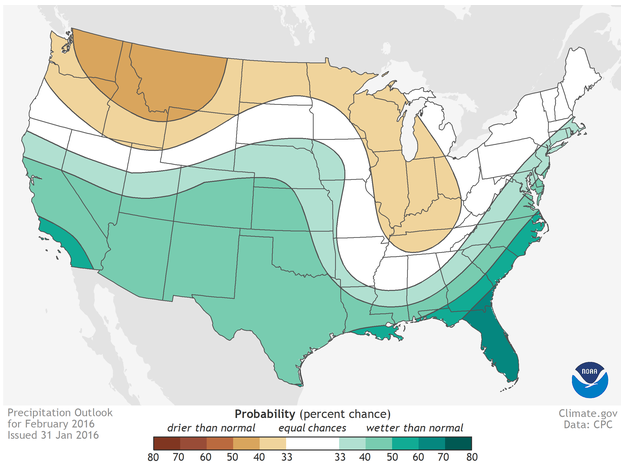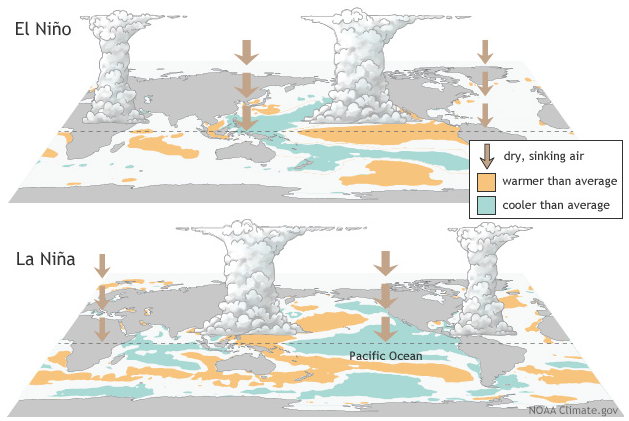What’s El Niño got to do with the crazy weather the U.S. has experienced the first several weeks of 2016? What’s El Niño got in store for the country through spring? How does El Niño impact the network UPS systems?
Let’s start at the beginning. What’s El Niño? El Niño is a periodic warming of the central and eastern equatorial Pacific Ocean. Every 2-7 years, this patch of ocean warms for 6-18 months, beginning in summer and building up through fall. The ocean’s temperature has already risen, but the consequences of these temperature anomalies occur during the colder months, aka now.

You will get dizzy reading NOAA (National Oceanic and Atmospheric Administration) and Weather Channel reports to get a handle on what El Niño means for our weather through Spring 2016. You will learn that our current El Niño is very strong compared to others in history, the strongest in 18 years AND its effects will impact our March/April weather. But specifically how and where?
Exact dates and geographies cannot be predicted. However, the nation’s weather experts roughly predict that, due to El Niño, the weather will be intensified:
- Heavy rain in the South, Gulf Coast, California and the desert Southwest to the central plains.
- Colder temperatures in the Southern half of the United States which, combined with the above, means the South may experience more ice.
- Heavy snowfall in the Great Lakes area and East Coast.
- Yet, overall in 2016, record breaking temperatures will put this year at the top of the list of hottest years on record.
The good news is that the U.S. northern region is likely to have warmer than usual temperatures. As well, tornados and hailstorms are likely to be fewer as a result of El Niño. But experts warn that forecasting tornados is hard because they happen in capricious clusters. One tornado can spawn many. And as John Allen a postdoctoral researcher at the International Research Institute for Climate and Society asserts, there’s danger in interpreting what a below-average year means. “It only takes one tornado to ruin your house and one major tornado to take your life,” he said.
Nature will have its way. Truth Number One, El Niño will cause weather drama, no doubt. Truth Number Two, El Niño’s effects cannot be tracked on a particular schedule. Big Truth Number Three, none of these weather conditions are good for power stability.
The impact of extreme weather on power outages is especially worrisome because of our nation’s antiquated power infrastructure, known grimly as “a power grid on sticks.” Even without El Niño level weather, nationally the incidents of constant, unpredictable power fluctuations are on the rise. Even in moderate weather, the nation’s old shaky “sticks” are vulnerable to damage and outages.
Now mix in El Niño and stir.
Network and server power issues are exacerbated. Heavy rains and flooding saturate the ground holding those power poles in place, uprooting them and downing power lines. Ice and heavy snowfall bear down on the poles, causing toppling, and densely coat power lines, causing breakage. Heavy snow pushed off the roads simply gets heavier and icier — making it more difficult for power companies to get to the lines and fix them.
Though extreme hot and cold temperatures don’t wreck power lines, these conditions cause the problem of excessive power usage. As everyone ramps up their heat and air conditioning, systems overload. Blackouts and brownouts occur when usage reaches peaks.
So how do you protect your systems from outages? First you must realize that your IT equipment can only withstand 16 milliseconds of an outage. If you are not prepared, your equipment does not have the chance to shut down properly, leaving you prone to data and equipment loss. That’s why Uninterrupted Power Supplies (UPS) were invented beginning in the 1950’s. A UPS is sensitive electronic equipment offering a stable supply of power, responsively as needed. The equipment used to be huge but today’s UPS units are small, portable and environmentally tolerant.
But don’t underestimate these small units. They are mighty protectors which will detect, verify and react to a power problem in 4 milliseconds. Their sensitivity is what makes them so effective in an outage. However, be aware: when a UPS is called into play by a power outage, its exquisite sensitivity is affected. That’s why you need to pay attention to keep them functional– recalibrating them, checking and reconditioning UPS batteries as needed. UPS maintenance is important in ordinary times but exponentially important as El Niño weather hits.
CoastTec experts are passionate about sharing information and keeping you in power. Call us today to ask questions about your UPS units and how to detect when servicing is needed at 410-521-1000. Learn more about our UPS Maintenance and Repair services. If you plan proactively, you can face El Niño weather with confidence.
And stay tuned: on the heels of El Niño comes La Niña in this Fall!
